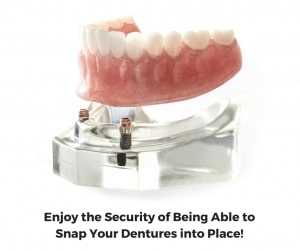Dental implants are the longest-lasting and most functionally restorative tooth replacement option. Our Georgetown implant dentists provide a variety of implant types, enabling us to offer this remarkable solution to nearly everyone.
If you have questions about dental implants or believe you could benefit from this service, give us a call at 512-819-9100 or contact us online to schedule a consultation at our Georgetown, TX office today.

What People Say About Us!
"I actually had fun during my recent visit. This is the only dental office you'll ever have to go to. Very friendly and professional. Amy is wonderful!!!"
Click here to read more reviews.
What are the Benefits offered by Dental Implants?
Depending on the type of dental implants you have placed, permanence will be one of the biggest benefits offered by this treatment. Unlike dentures and dental bridges that can come loose or fall out, most dental implants are secured by metal framework or bone, enabling them to stay in place for a lifetime.
Additional benefits offered include:
- Full restoration of bite tension
- Complete functional restoration
- No special care required
- No reliance on adjacent teeth for support
Implants placed into bone will also protect against jaw shrinkage and collapse. When a tooth is missing, so too is its root, and it is the root of teeth that informs the body that bone is needed in specific areas of the jaw. Most tooth replacement options simply address the missing crown. Dental implants replace the root, continuing those signals and preventing the body from utilizing jawbone minerals elsewhere. During your initial consultation, we would be happy to discuss this in greater detail.
Candidates for Dental Implants
The best candidates for dental implants are in generally good health, free of gum disease and excessive tooth decay, and prepared for oral surgery. There will be a recovery period following the placement of your implants. Good candidates need to be prepared to take a few days off to rest and to follow postoperative instructions during that time.
The density of your jawbone will play a role in your dental implant candidacy as well, though with our many implant options, should not preclude patients with narrow or significant jawbone deterioration. The best way to learn if you are a good candidate is through a one-on-one consultation with Dr. Mandy, Dr. Mark, or Dr. Devin.

What Types of Dental Implants does Aesthetic Dentistry offer?
While there are many types of dental implants, root form implants are far and away the most common. Placed directly into jawbone, root form implants undergo a process called osseointegration by which they become a permanent part of the jaw. Once this process has completed, root form implants can be used to support a crown, bridge, or dentures, making them ideal for a variety of tooth restorations.

Our Georgetown implant dentists may recommend root form implants to support a bridge if you are missing several teeth in a row. Using implants to support a dental bridge allows us to rebuild your smile with fully functional teeth.
We also offer implant supported dentures for patients who need to replace an entire arch of teeth. Implant supported dentures are stronger and more reliable than traditional options, and provide the greatest restoration of function and beauty.
Implant supported dentures snap into place with as few as two implants, though up to four may be needed for an entire arch. With either option, these dentures eliminate the frustration and insecurity brought about by traditional methods of securing artificial teeth.
How Do I Know Which Dental Implant Is Right for Me?
During your dental implant consultation at our Georgetown area office, we will carefully assess your jaw, discuss all of your options, and help you choose the implant type best suited to meet your needs.
Myths and Misconceptions About Dental Implants
Despite being a standard dental procedure, there is much that is misunderstood about receiving dental implants. Some myths and misconceptions about dental implants include these statements:
Implant surgery is risky.
The truth is that dental implants are one of the lowest-risk surgeries in the medical/dental field, and the success rate is 95 percent.
Dental implant maintenance is difficult.
On the contrary, taking care of your dental implants is as easy as regular tooth maintenance. You should brush, floss, and use mouthwash to keep the dental implant clean and healthy.
Dental implants don't look like natural teeth.
This is completely untrue. From the perspective of someone looking at you, your dental implant looks exactly like a natural tooth. A mold is made of your existing tooth to create the crown for the implant. It fits perfectly in between your other teeth.
Implants last forever.
This is only partially true. Depending on when you get your implant and how well you take care of it, your dental implant will last many years. If the implant is damaged or wears down for any reason, it can be replaced with a new one. However, many people never need a replacement, and their implants last the rest of their lives.
Dental implants take forever to heal.
Your dentist will give you aftercare instructions and realistic expectations of how long your implant will take to heal. However, the incision is small, so it only takes a few weeks to become healed.
Dental insurance won't cover my implant.
Most dental insurances cover at least part of the cost of your dental implant, but to find out for sure, consult with your insurance company. Your dentist can give you an estimate to submit to the insurance to determine coverage.
What Are the Risks of Dental Implants?
No surgery is risk-free, but placing dental implants is very low risk. Studies have shown the success rate for dental implants to be 95 percent. Before committing to your dental implants, you should be aware of the following risks.
By getting dental implants, you may experience some pain that lasts longer than is standard. Dental implants may also lead to a risk of infection without proper care or cleaning. As long as patients can diligently follow their aftercare guidelines, these risks and complications should not occur.
Are Dental Implants Painful?
Placement of a dental implant isn't a painful procedure. However, because you are having minor gum surgery when the implant is first put into your jawbone, there is a small amount of pain that you may experience during recovery. Luckily, this discomfort can usually be dealt with using over-the-counter pain medications. At first, you may feel an ache where the implant has been placed, but that should reduce in time. When the post is attached to the implant, it requires another minor gum incision. This heals quickly once the post is attached. Adding the crown to the implant is a completely painless process. There is no recovery needed afterward.
What Is Recovery Like After Getting Dental Implants?
Dental implants generally have a three- to six-month process from beginning to end. If you need reconstructive bone work beforehand, the timeline is longer. Recovery is minimal and can be completely done at home. In fact, most patients often return to work the next day.
Contact Us
Interested in improving your smile and optimizing your oral health? Schedule a consultation at Aesthetic Dentistry today by clicking here. With an accomplished team of doctors, we are dedicated to helping patients in Georgetown and the surrounding Texas communities with high-quality oral care. To find out more about dental implants, call us at 512-819-9100 .


